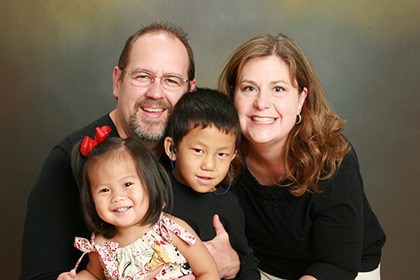In his young life Nathan Spencer has already overcome many challenges.
Nearly four years ago he was found wandering in a park in his native China, abandoned and alone.
Deaf and with meagre communication skills, he also had no name.
“They found him in the park on Nov. 9, but his actual birthday is unknown,” said Lisa Spencer, his adoptive mother.
The boy was 6 years old, authorities estimated, when the Spencers officially adopted and brought him to Auburn. The Spencers earlier adopted a girl, Emily, now 4.
Nathan turns 10 on Sunday – a birthday the family decided on, one day after his discovery in the park in 2009.
“He’s an amazing child,” Lisa said. “He’s made some amazing strides. My husband (Art) and I truly believed we were going to raise him in the deaf community, using American Sign Language (ASL).”
But the boy is getting careful attention.
Nathan, profoundly deaf with cochlear implants, continues to flourish, buttressed by the support of his family and a private school in Shoreline.
The Northwest School for Hearing-Impaired Children (NWSFHIC) has helped the Spencers and other families with deaf children bridge the language and hearing gap.
The school works with 40 children from China, Korea and Japan, and with Hispanic students, in preschool through the eighth grade.
NWSFHIC contracts with 22 school districts throughout the Puget Sound Region – from Hood Canal to the Cascades, from Auburn/Kent Valley to Skagit Valley – to provide free education and transportation to qualifying students.
Nathan excels at a school that emphasizes spoken communication paired with simultaneous Signing Exact English (S.E.E.), in which the speaker signs every important part of each word, using grammatically correct English.
“S.E.E. helps children make sense of the auditory input provided by their cochlear implants or hearing aids. If they can’t hear certain words or parts of words, we supply them with S.E.E. signs so that grammatically-correct English is developed for academics and social communication,” explained Dr. Barbara Luetke, the school’s outreach and literacy coordinator and the mother of two grown deaf daughters raised on the S.E.E. method.
All communication from teachers to children at NWSFHIC is spoken and signed concurrently, to encourage students to speak in complete sentences.
“In the public school, Nathan used American Sign Language. He didn’t communicate with us at all. He didn’t even sign his name. … He learned to play games, but he couldn’t read,” Lisa said. “After he switched to Northwest, within a month and a half he was reading.”
Nathan is now in the third grade.
“He’s smart … he’s a remarkable boy,” Lisa said. “We feel so incredibly blessed that (the school) is here in Shoreline. It’s a long drive for my son, but it’s the only one there is. … People all over the country come here. He’s a changed little boy.”
Lisa, a volunteer at the school, shares art projects with the kids.
“It’s amazing to see these children and see how much they can do, because this is a very hard part of our population to teach,” she said.
Years from now, Nathan can expect to join the 100 percent of NWSFHIC grads who complete high school, school officials said. He also is likely to join the more than two-thirds of NWSFHIC alumni who graduate from college, and the 85 percent who are employed and live independently of their parents, school officials said.
=====
To learn more, visit www.northwestschool.com.



